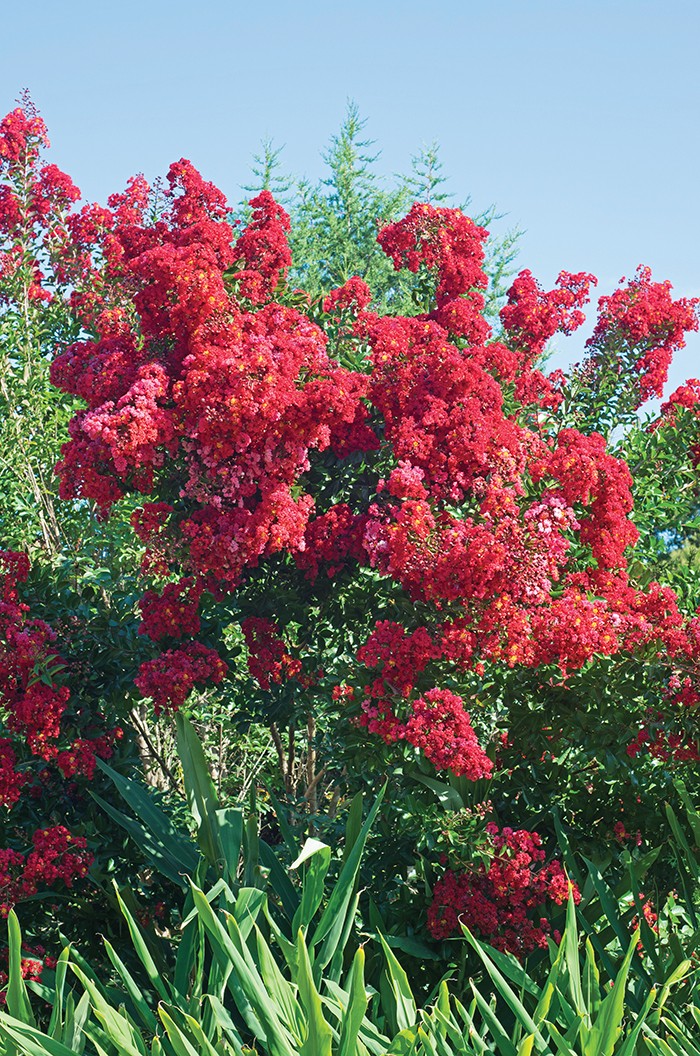PSSST! Ya wanna know a secret about me? Well, please don’t tell anyone, but every summer, I do enjoy watching naked ladies romp in my garden.
Now, before you think I’ve gone woefully weird or am trying to get Cary Magazine slapped with an R rating, let me explain. The naked ladies I adore are plants, not people, so call off the morality police.
Naked ladies (botanically tagged as Lycoris squamigera, and also known as surprise lilies or resurrection lilies) are bulbous beauties related to the popular red spider lilies (Lycoris radiata). In the early spring, these ladies show off skirts of long, strap-like green leaves, which common wisdom would suggest to complement a soon-to-follow flower show. Instead, this foliage in its full prime suddenly dies back, leaving these ladies stripped down to bare nothings and puzzled gardeners left to wonder if they killed their plants.
However, come August, these teasers suddenly, salaciously sprout skinny green scapes from the earth to expose their naughty namesake in the form of large, conical flowers blushing in shades of pretty pink. After the blooms die back, naked ladies slip into another dormant slumber, resting until the following spring, when they will start their strange cycle of horticultural hoochie koo all over again.
When they are dormant, meaning either now or early fall, is a good time to find and plant naked lady bulbs. Contact local garden centers to see if they have any on hand, and if that doesn’t work, Plant Delights Nursery (plantdelights.com) in Raleigh has them, as well as Brent and Becky’s Bulbs (brentandbeckysbulbs.com), who actually don’t start shipping from their Virginia farm until after the leaves die back in late spring.
Naked ladies — deer resistant, by the way — flaunt best in sunny areas with organically rich, well-draining soil. If properly cared for, they will naturalize, producing off set bulbs in the process that can be transplanted to other parts of your landscape or given to fellow gardeners.
If you are looking for instant gratification from these beauties, you’ll have to cool your jets for at least the first year they are in the garden. Naked ladies do resent being disturbed — meaning dug up and replanted — and they usually show it by sulking during their first bloom period, producing few, if any, blossoms. After a year of settling in, however, these sassy sensations will ramp up a flower show that will only get better in the years to come.

Now is a good time to see the true bloom colors of such crape myrtle beauties as ‘Red Rocket.’
Crape myrtles can be purchased anytime during the year, but buying them in midsummer adds the advantage of seeing these beauties in bloom — and the true colors of their flowers. Plant tag images can fade, and they aren’t always accurate, so eyeballing the actual blossoms is the way to go. Any crapes planted during the scorch of the summer should be given well-prepared planting holes, plenty of mulch, and regular waterings. A good alternative is to simply temporarily tuck away your new crape cuties with their pots in a semi-shady spot, water them weekly, and wait until the fall, which is a prime planting time for woody ornamentals.
To Do in the Garden
June
- When irrigating new plantings, encourage developing roots to reach down into the soil with thorough waterings, not quick spritzes here and there. Plants with shallow root systems are more susceptible to stress during the hottest, driest times of the growing season.
- To bulk up for a bountiful harvest through the long summer haul, after veggies such as green beans, okra, peppers, squash, tomatoes, and eggplants begin to set their first crops, replenish their nutrient needs by side dressing with a common fertilizer such as 8-8-8 or 10-10-10.
July
- If your home is adorned with tropical houseplants such as rubber tree, fiddle leaf fig, dracaena, or peace lily, be kind to these pretties and water them right. Instead of using chilly water straight from the faucet, fill a jug and let it warm to room temperature before giving your plants a drink.
- For best flavors and fragrances, harvest herbs early after the morning dew dries off of the foliage. This is when essential oils are more concentrated in their leaves.
- Things to Do: June/July 2022
- Notable Teens 2022
- The Rise of Board Game Cafés
- Family Volunteerism
- Sea-nic Boat Racing
- Small Business Spotlight: Bumble Brews
- Nonprofit Spotlight: The Alice Aycock Poe Center for Health Education
- Restaurant Profile: A’Verde Cocina + Tequila Library
- Bibibop
- Liquid Assets: The Ultimate Bloody Mary from The Blind Pelican Seafood House
- Liquid Assets: Crème de l’Orange Cider from Bull City Ciderworks
- On Trend: Private Theater Rentals at Paragon Theaters
- Garden Adventurer: Naked Gardening







